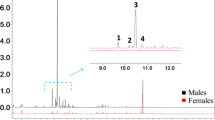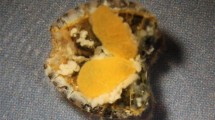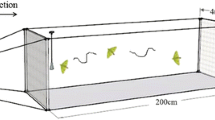Abstract
Six electrophysiologically active aromatic compounds, viz., anisole, benzaldehyde, veratrole, guaiacol, phenylacetonitrile, and phenol, were identified in the volatiles of older-adult male desert locust. Young adults and females of all age groups produced none or only trace quantities of these compounds. Comparison of the aggregation responses of young and older adults to the crude, older-adult, volatile extract and different synthetic blends of the six compounds showed that the aggregation pheromone system of the adult gregarious locust consists of phenylacetonitrile, guaiacol, phenol, and benzaldehyde. Like the crude volatile extract of older males, neither the synthetic blend of the six compounds nor the adult pheromone blend evoked any significant aggregation responses from nymphs. These results confirm our previous report of sexual differentiation in the production of adult aggregation pheromone in the desert locust and of the evidence of two distinct aggregation pheromone systems in the two stages of the insect.
Similar content being viewed by others
References
Fuzeau-Braesch, E., Genin, E., Jullien, R., Knowles, E., andPapin, C. 1988. Composition and role of volatile substances in the atmosphere surrounding two gregarious locusts,Locusta migratoria andSchistocerca gregaria.J. Chem. Ecol. 14:1023–1033.
Gillett, S.D. 1968. Airborne factor affecting the grouping behaviour of locusts.Nature 218:782–783.
Greenwood, M., andChapman, R.F. 1984. Differences in numbers of sensilla on antennae of solitarious and gregariousLocusta migratoria (Orthoptera: Acrididae).J. Insect Morphol. Embryol. 13:295–301.
Hoyle, G. 1951. Potassium ions and insect nerve muscle.J. Exp. Biol. 30:121–135.
Linn, C.E., Jr., Bjostad, L.B., Du, J.W., andRoelofs, W.L. 1984. Redundancy in a chemical signal: Behavioral responses of maleTrichoplusia ni to a 6-component sex pheromone blend.J. Chem. Ecol. 10:1635–1658.
Nolte, D.J. 1963. A pheromone for melanization of locusts.Nature 200:660–661.
Nolte, D.J. 1976. Locustol and its analogues.J. Insect Physiol. 22:833–838.
Nolte, D.J., May, I.R., andThomas, B.M. 1970. The gregarisation pheromone of locusts.Chromosoma 29:462–473.
Nolte, D.J., Eggers, S.H., andMay, I.R. 1973. Locust pheromone: Locustol.J. Insect Physiol. 19:1547–1554.
Obeng-Ofori, D., Torto, B., andHassanali, A. 1993a. Evidence for mediation of two releaser pheromones in aggregation behavior of the gregarious desert locustSchistocerca gregaria (Orthoptera: Acrididae).J. Chem. Ecol. 19:1665–1676.
Obeng-Ofori, D., Njagi, P.G.N., Torto, B., Hassanali, A., andAmiani, H. 1994. Sex differentiation studies relating to releaser aggregation pheromones of the gregarious desert locustSchistocerca gregaria (Orthoptera: Acrididae).Entomol. Exp. Appl. In press.
SAS Institute. 1985. SAS Users Guide. Statistics. Version 5 ed. Cary, North Carolina.
Todd, J.L., Haynes, K.F., andBaker, T.C. 1992. Antennal responses specific for redundant pheromone components in normal and mutantTrichoplusia ni males.Physiol. Entomol. 17:183–192.
Author information
Authors and Affiliations
Rights and permissions
About this article
Cite this article
Torto, B., Obeng-Ofori, D., Njagi, P.G.N. et al. Aggregation pheromone system of adult gregarious desert locust schistocerca gregaria (forskal). J Chem Ecol 20, 1749–1762 (1994). https://doi.org/10.1007/BF02059896
Received:
Accepted:
Issue Date:
DOI: https://doi.org/10.1007/BF02059896




